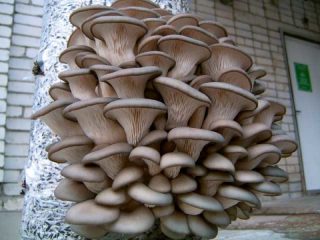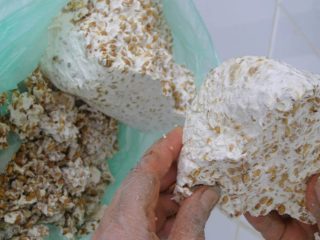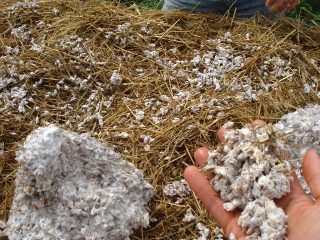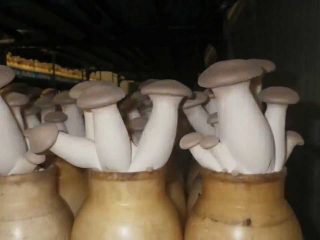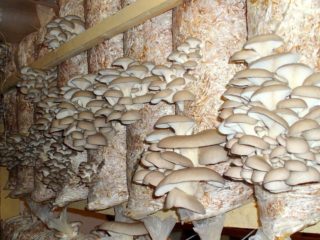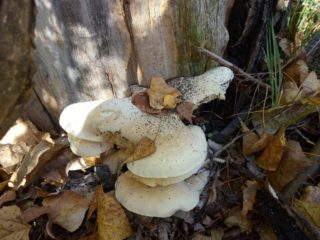Content
Oyster mushrooms are found in the wild; they are also grown on an industrial scale and at home. They are common in Europe, America, Asia. In Russia they grow in Siberia, the Far East, and the Caucasus. They prefer a temperate climate zone and are resistant to cold. Photos of oyster mushrooms and their description are presented in the article.
What are oyster mushrooms
Oyster mushrooms are edible lamellar mushrooms. In the natural environment they grow on the remains of deciduous trees, stumps, dead wood, branches, and dead wood. They prefer oak, rowan, birch, willow, and aspen. Rarely found on conifers. On vertical trunks they are usually located high. They grow in groups in more than one layer, and form bunches of several fruiting bodies - up to 30 pieces. Rarely found alone.
Oyster mushrooms are cultivated on an industrial scale and grown at home. Along with champignons, these are one of the most popular mushrooms presented in the retail chain. The most common is ordinary, or oyster.
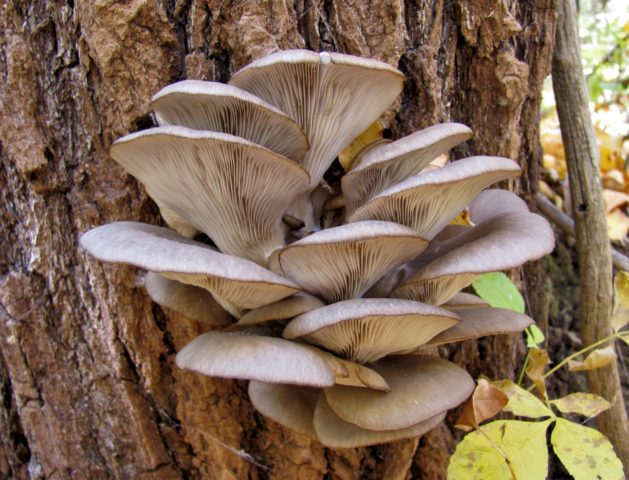
Photo of oyster mushrooms growing in the wild
What do oyster mushrooms look like?
In appearance, oyster mushrooms are similar to each other. They consist of a cap, which smoothly turns into a stem, tapering towards the base. The latter in most species is not pronounced, short, often lateral, and curved. Color – white, gray or yellowish. It reaches a length of up to 5 cm and a thickness of up to 3 cm.
The cap is solid, thinner towards the edges. The shape can be different: oval, round, horn-shaped, fan-shaped, funnel-shaped. Diameter - from 5 to 17 cm, in some species - up to 30 cm.
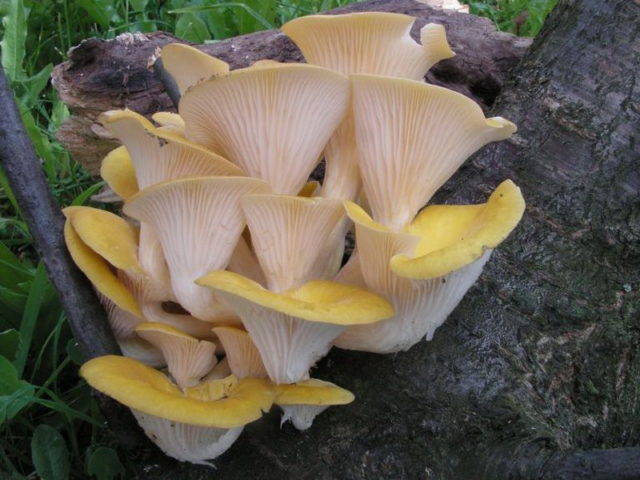
The color of mushrooms depends on its type
Oyster mushrooms are white, light gray, cream, pinkish, lemon, ash-violet, grayish-brown.
The plates are descending, the spores are cream, white or pinkish.
The flesh of a young specimen is elastic, thick, juicy. In older people it becomes fibrous and tough. Different varieties of oyster mushrooms with descriptions are presented below.
Are oyster mushrooms edible?
These mushrooms are edible or conditionally edible. Even those that do not taste good can be eaten, since they are not poisonous.
It is recommended to eat young specimens, no larger than 10 cm in size, without a hard leg.
Mushrooms contain all the beneficial substances necessary for humans: vitamins, amino acids, carbohydrates, fats, microelements. They are rich in iron, potassium, calcium, iodine. Vitamins included: C, E, D2, PP, representatives of group B.
Oyster mushrooms can be fried, stewed, baked, salted, added to sauces, and used as an additional ingredient in other dishes. They are consumed only after heat treatment. They contain chitin, which is not absorbed by the body, so mushrooms need to be finely chopped and cooked at high temperatures.
The aroma is reminiscent of the smell of fresh rye bread; it tastes like russula.
Types of oyster mushrooms in the forest with photos and descriptions
There are several dozen varieties of oyster mushrooms. The division is quite arbitrary. The classification depends on the type of tree on which they grow. Photos and descriptions of forest oyster mushrooms are presented below.
Oyster
Another name is oyster mushrooms. These edible mushrooms grow in mixed and deciduous forests of the temperate zone. They inhabit the remains of wood: dead wood, rotten stumps, branches. Sometimes found on weakened live oaks, aspens, and birches.
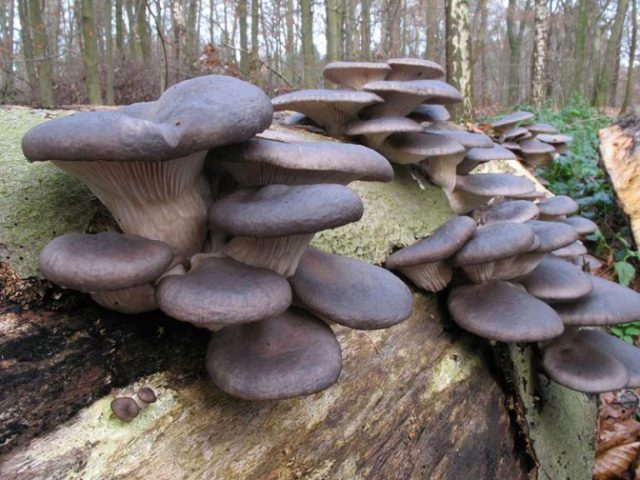
They form multi-tiered colonies, merging with fruiting bodies into bundles
The cap is 5-15 cm in diameter. The color is from light gray to ashen with a purple tint. The pulp is thick, with a pleasant mushroom smell and taste with notes of anise.
Fruits from August until frost in early December.
Covered
Other names for oyster mushroom are single, sheathed. In a young mushroom, the shape of the cap is kidney-shaped, sessile, in a mature one it is fan-shaped, the edges curl down. Diameter - from 3 to 5 cm, sometimes reaches 8 cm. The color is grayish-brown or flesh-brown. The plates are wide yellowish, there is a light cover on it, which breaks during the growth process and is preserved in the form of rather large flaps. The pulp is thick, dense, whitish, with the smell of raw potatoes. There are practically no legs. Fruits from April to June. It grows in groups, but not in clusters, but singly. Found in northern and central Europe. It is classified as edible and can be eaten fried or boiled. It is tough due to its dense flesh.
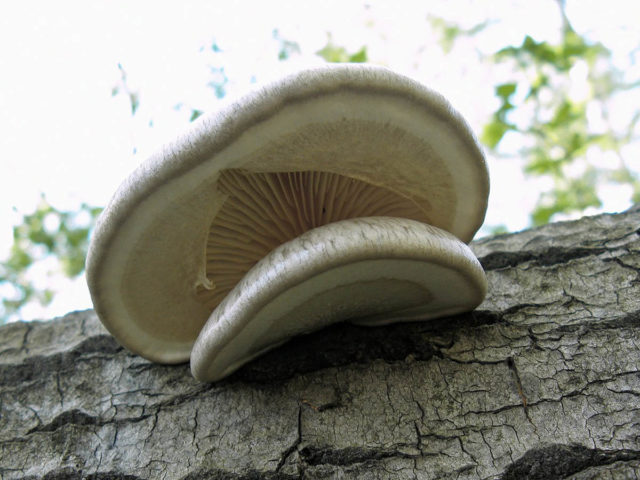
A distinctive feature of the single oyster mushroom is a blanket on the plates
Horn-shaped
The cap has a horn-shaped or funnel-shaped shape, sometimes it is leaf-shaped or tongue-shaped. Size – from 3 to 10 cm in diameter. The surface is smooth, the color ranges from almost white to grayish-ochre. The pulp is thick, elastic, white, and in old mushrooms it is hard and fibrous. The plates are sparse, sinuous, white, descending, descending to the very base. The stem is pronounced, long - from 3 to 8 cm, its thickness is up to 1.5 cm. Fruits from May to September on dead wood of deciduous trees. Found in windbreaks, clearings, and dense bushes. Considered edible.
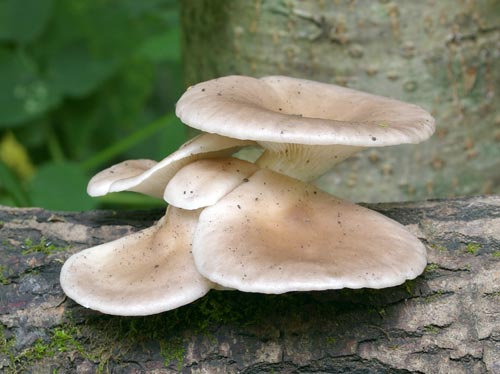
Groups of mushrooms can create bizarre shapes
Pulmonary
Other names: spring, whitish, beech. An edible, commonly found mushroom with a rounded whitish or cream cap, reaching a diameter of 4-10 cm. The flesh is elastic, white or whitish-grayish, with a pleasant faint smell of mushrooms. The leg is often lateral, less often central, with hard flesh, dirty white, hairy, 4 cm long. Found on rotten or weakened living trees, it can grow in bunches and large groups. Fruits from May to September.
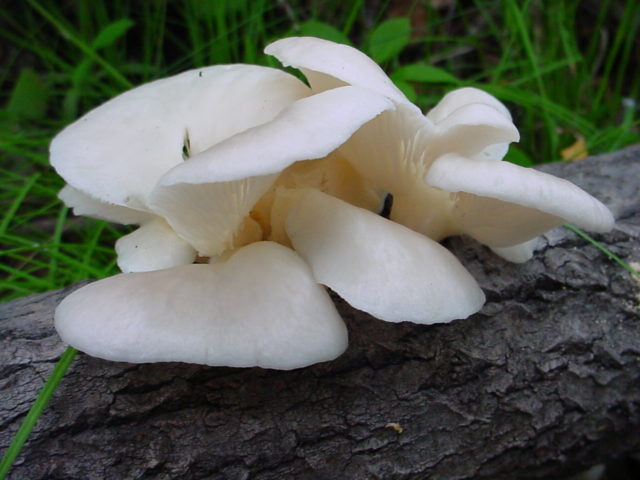
This species is distinguished from others by its white color
It is considered the most common variety of oyster mushrooms in the forests of Russia. It grows in the wild and is prized by mushroom pickers.
Oak
Quite a rare species, rarely seen. The cap is ellipsoidal or rounded, less often tongue-shaped, bent down. Size – from 5 to 10 cm. Color whitish-grayish or brownish. The surface is covered with small scales, rough. The pulp is thick, light, elastic, with a pleasant mushroom smell. There is a private cover on the lamellar layer.
The leg is short, tapering downwards, eccentric, thick.Its length is from 2 to 5 cm, thickness is from 1 to 3 cm. The color is like the cap or a little lighter, the flesh is white or yellowish, hard and fibrous below.
Grows on dead oaks and other rotting wood of deciduous trees. Fruits from July to September.
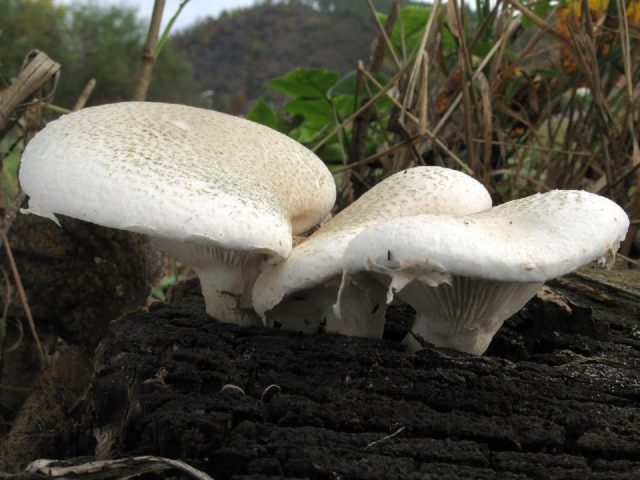
The oak oyster mushroom is distinguished by the scaly surface of the cap and the remains of the spathe
Pink
A small, beautiful mushroom with a pink, slightly convex cap measuring 3 to 5 cm. The flesh is light pink with an oily texture. The leg is lateral, short. In nature, it is found more often in the tropical zone, adapted to hot climates, and grows very quickly.
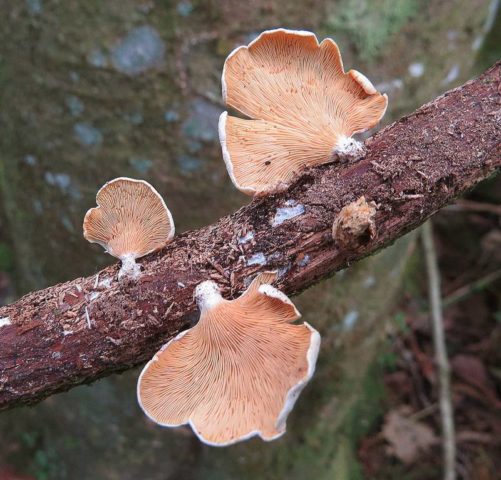
Pink oyster mushroom prefers warm climates
Lemon
Other names: ilmak, yellow oyster mushroom. Refers to decorative and edible. Found in groups, individual specimens grow together as fruiting bodies. The cap is yellow-lemon, the flesh is white, tender in young mushrooms, hard and rough in old ones. Size - from 3 to 6 cm in diameter, sometimes reaching 10 cm. In young people it is thyroid, in old ones it is funnel-shaped, with lobed edges. In mature mushrooms, the color of the cap becomes faded.
The plates are narrow, frequent, descending, pinkish. The powder is whitish or pinkish-violet.
The leg is white or yellowish, first central, then becomes lateral.
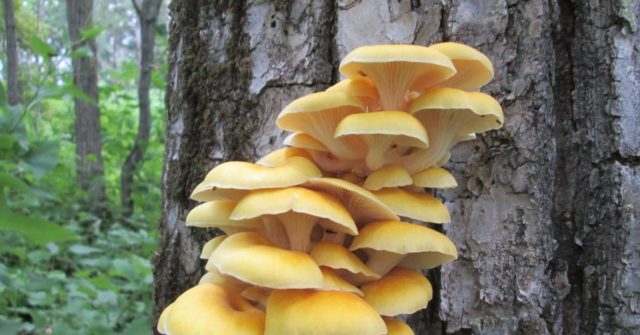
Lemon oyster mushroom cannot be confused with other species
Grows in mixed and deciduous forests. Distributed in the south of the Far East. In the Primorsky Territory it grows on elm dead wood and dead wood, in more northern regions - on birch trunks. Fruits from May to September.
Stepnaya
Another name is royal. The white mushroom has a slightly convex cap at first, which then becomes funnel-shaped. Size – up to 25 cm in diameter. The pulp is white or light yellow, thick, dense, sweetish.The leg is often central, sometimes lateral.
Widespread in the steppe, it bears fruit only in spring - from April to May. In the southern regions it appears in March. Grows in steppe and desert zones. It settles not on wood, but on the roots and stems of umbrella plants.

Steppe oyster mushroom is considered a valuable mushroom with high taste qualities
It resembles milk mushrooms and champignons, but the flesh is a little coarser.
Conclusion
Photos of different types of oyster mushrooms can be seen in the article. Wild specimens come in several varieties. Their fruiting bodies are a low-calorie dietary product containing a full range of elements necessary for the body.
